Pawpaw’s Gun: The Real McCoy

Halfway through a box of lavish bismuth shot, watching yet another rooster soar (unscathed) into the sunrise, I began to question my devotion to the idea. The echoes from the peanut gallery didn’t help my confidence in the matter. Are you sure you don’t want to go back to the truck and swap out guns? I worked the bolt and dismissed the notion of swapping guns. To do that would be to quit, and that wasn’t going to happen.
Article Sponsored by Sage & Braker Fine Gun-Cleaning Products
Written by Ian Burrow
Halfway through a box of lavish bismuth shot, watching yet another rooster soar (unscathed) into the sunrise, I began to question my devotion to the idea. The echoes from the peanut gallery didn’t help my confidence in the matter. Are you sure you don’t want to go back to the truck and swap out guns? I worked the bolt and dismissed the notion of swapping guns. To do that would be to quit, and that wasn’t going to happen. It was the second day of our hunt, somewhere in that aggregate 30,000 step range, I was wielding my grandfather’s Sears & Roebuck bolt action 20-gauge shotgun, and my vest still didn’t have a single feathered carcass tucked away inside it.
To my left and right walked Italian auto-loading works of art that could dispatch multiple birds with just a few quick twitches of the finger. If not multiple birds in one flush, then they could certainly offer the shooter the safety net of a follow up shot (or two) before their quarry flapped out of range. I was beginning to envy them. I couldn’t rack the bolt, load a new shell, and raise my shotgun in the same amount of time my compadres could pop off three successive shots. The safety on my grandfather’s gun – forward for safe, back for fire – was cumbersome. The barrel, forged to a permanent modified choke, certainly wasn’t helping with the near-flushing birds. I felt handicapped.
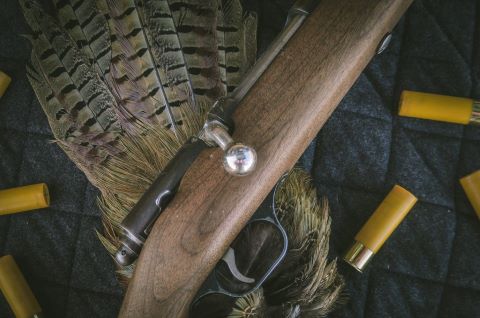 Papaw’s 20-gauge Sears & Roebuck bolt-action shotgun.
Papaw’s 20-gauge Sears & Roebuck bolt-action shotgun.But I’ve been handicapped before and that experience taught me a good deal. Nearly a decade ago I broke my back to the tune of a George Strait song while chasing a gold buckle from the National Finals Rodeo. I’ll be the first to tell you that there isn’t a beautiful woman on God’s green earth that won’t stop and listen to a young rodeo cowboy, stuck in a wheelchair, introduce himself and tell his story. But, as good of a life lesson as that was, the bigger takeaway was realizing just how much I loved feeling like the real McCoy a year later when I strapped my spurs back on. Gold buckle or not, nobody could ever say there was lack of heart. I think I’ve been chasing that feeling of authenticity, that feeling of being the real McCoy, ever since.
Russell, my paternal grandfather, was the real McCoy. The Dust Bowl drove him from a desolate Oklahoma township and led him to employment through the Works Progress Administration (WPA) where he mailed the bulk of his checks back home to his mother throughout the Great Depression. The second World War later transplanted him from the WPA into the Navy where he met my grandmother and served as a flight instructor for the duration of the war. Following VJ Day (Victory over Japan Day), he received an honorable discharge and found work with the global aerospace superpower, Boeing, in Wichita, Kansas. It was in Wichita that he would raise his family, serve as a deacon of his church, and tend to his tomato garden until old age called him to eternal rest.
What I didn’t know, until after his passing, was that Papaw was an avid sportsman. By the time I was of a cognitive age he was well into his 80’s and his fishing rods and shotgun had been collecting dust for quite some time. Following his passing, I was bequeathed his firearm collection: .22 caliber rifle, .410 youth break open shotgun, and a 20-gauge bolt action shotgun. All of which were department store firearms. Their plain wood, worn bluing, limited magazine capacities, and small cartridge sizes left a younger me unimpressed. I politely accepted them, briefly gave them the once-over, and then tucked them away in the furthest corners of my gun cabinet. It would take years before I realized how special those guns are.
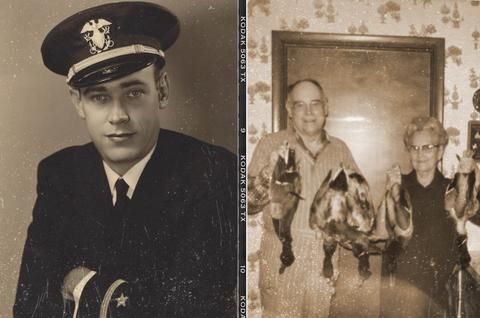 The author’s grandfather, Pawpaw.
The author’s grandfather, Pawpaw.I couldn’t tell you what the catalyst was, but I can tell you the exact moment that it happened. The night before dove season opened here in Kansas this fall, as I clambered up the stairs trying to pack the car for the morning’s hunt, I paused: You should try and shoot a dove with Papaw’s gun. Arms full of boxes of shot shell, my auto loader strapped to my back, I pivoted and headed back to down the stairs. From the furthest reaches of the cabinet, for the first time since it was imparted on me, I withdrew my grandfather’s single shot, 20-gauge, 2¾-inch chambered Sears & Roebuck Ranger 101.3 shotgun. Why not?
Now, full disclosure, I’m not exactly a hardcore dove hunter. In fact, if I had to rank my favorite hunts, dove hunting would pretty much fall at the bottom of that list. Maybe that’s why I felt comfortable heading afield with Papaw’s gun. If it didn’t work out and I couldn’t bag a single bird, then so be it. I quickly realized how much I relied on that second or third follow up shot on a fleeting set of feathers that my auto loader so graciously offered. This old bolt gun was forcing me to slow down. To breath. To focus on a single bird. To squeeze and follow through.
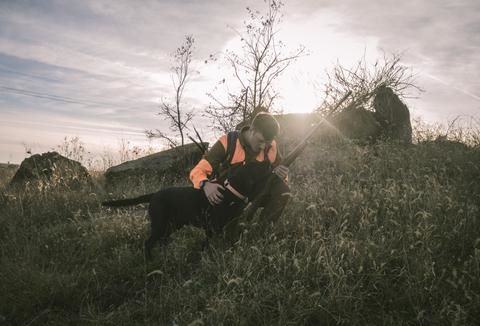 The author with Pawpaw’s shotgun and his Black Lab.
The author with Pawpaw’s shotgun and his Black Lab.The more the birds hit the dirt, the more I pondered on my grandfather’s experiences afield. Following a limit of doves, I headed home with a newfound curiosity of American history and familial pride. My first question was… what was this thing? No serial number, no manufacturer name displayed, and not even a stamp on the barrel to declare its cartridge or chambering – it was quite the mysterious dove killer. Upon close inspection, I found four distinct markings:
- “Ranger 101.3” on the barrel, near the receiver.
- A lone “A” on the barrel, where it connects to the chamber.
- Something that looks like a hybrid gender symbol, slightly below the “A.”
- “Safety <–>” beneath the bolt, above the thumb safety lever.
With these clues in hand, and a few context clues from my dad, I set out on a quest to discover the history behind this gun. I scoured forums and blogs, databases and journals. I called gunsmiths and friends and compiled my notes.
 The author proudly carrying Pawpaw’s 20-gauge, bolt-action Sears & Roebuck shotgun.
The author proudly carrying Pawpaw’s 20-gauge, bolt-action Sears & Roebuck shotgun.“I know he used it for duck and rabbit. Probably turkey, and anything else that was moving in southwest Oklahoma found itself at the end of that gun sight,” my dad explained. “That gun put dinner on the table for several decades…. Up until he secured his job with Boeing.” That’s when I realized this simple 20 gauge didn’t feed a hobby; it literally fed a family. I felt so foolish. As much pride as I take in attaining meat from my hunting pursuits, I’ve been so fortunate that if I came home empty handed from a hunt, neither my wife nor I would go wanting. But, for quite a while, that wasn’t the case with my grandfather. Damn, talk about being the real McCoy.
Slowly, I pieced together the story behind Papaw’s gun. I found a scanned 1936 Fall Issue of the Sears and Roebuck catalog. A light 1,176 pages of gramophones, houses (you could literally purchase a home via the Sears and Roebuck catalog), bear traps, wicker chairs and anything else you could ever think of. I felt as if I’d discovered a prehistoric Amazon.com. I clicked through the scanned images until I found the firearms section. There it was. The Ranger 101.3 shotgun for a whopping $5.75. Fast forward to today, the inflation brings that sticker price to about $107.18. A search through various antique firearm dealers informed me that this same gun could be purchased for $100-120 dollars. This gun had retained its value, down to the penny, for almost a century and it could still smack a dove at 40 yards.
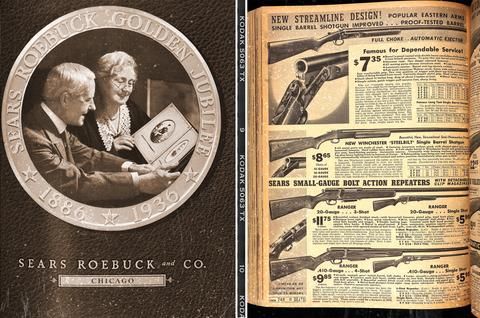 Pawpaw’s shotgun as it appeared in the Sears & Roebuck catalog of 1936.
Pawpaw’s shotgun as it appeared in the Sears & Roebuck catalog of 1936.There were several other firearms on the same page with more features and bigger price tags. I can really only speculate, but based off that, I’m led to believe that he made a very intentional purchase. He wanted to purchase a gun that was within his means that was also reliable and effective. He wasn’t caught up in the frills of the latest innovations of that decade. He just wanted to provide for his family. The fact that his gun has survived nearly 100 years is a testament not only to his decision making, but to his careful devotion to caring for his firearm. Both of which are why I can still hunt with the same gun today.
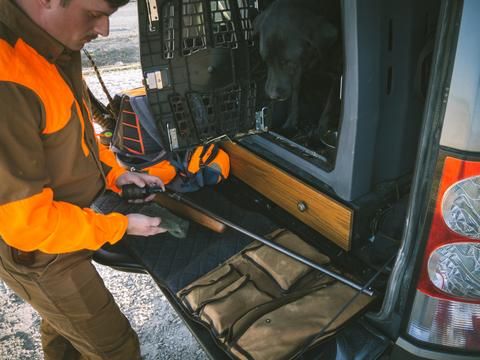 The author field cleaning Pawpaw’s shotgun on his Sage & Braker Shotgun & Rifle Cleaning Mat.
The author field cleaning Pawpaw’s shotgun on his Sage & Braker Shotgun & Rifle Cleaning Mat.Realizing how influential this firearm was on my grandfather’s life, I felt inspired to bring this workhorse out of retirement and start seriously hunting with it. Part of me loved the idea of the challenge it brings to the field: I get one shot, it’s going to be a 20 gauge and it’s only going to be 2¾ inches. Raised in an age of magnum chambers and premium shot technology, it’s practically unfathomable that someone would hunt with such a small shell and simple gun. But that challenge aside, there’s something to the touch of the worn wood that keeps me pulling Papaw’s gun out of the cabinet. Something far more significant than just the gratification that comes with overcoming a self-imposed challenge.
This past weekend I shot my first wild pheasant, and I did it with Papaw’s gun. To my fellow hunters, you understand the pure sense of joy that comes with each “first.” As much as I loved shooting my first wild pheasant, what I really enjoyed was shooting my first wild pheasant with my grandfather’s gun. Just like how he did, decades ago. I know it’s a stretch, or dare I say a “long shot,” but there’s a small part of me that feels like if I can put food on the table with this gun, just like my grandfather did, then maybe one day I can be a fraction of the man he was. That maybe one day, when it comes to being a husband, a father, and family man, I can be the real McCoy. Just like Papaw.
Ian Burrow discovered his affection for hunting as an adult. Although he is still a novice of the passion in many respects, he strives to mentor new hunters as often as possible, knowing firsthand just how daunting it can be to take up hunting for the first time. Ian is a U.S. Army veteran and currently works for a software company that builds the technology that state agencies use to sell and manage their hunting and fishing licenses. He is married to his beautiful wife, Alexis, and they currently reside in North East Kansas.

Ian Burrow discovered his affection for hunting as an adult. Although he is still a novice of the passion in many respects, he strives to mentor new hunters as often as possible, knowing firsthand just how daunting it can be to take up hunting for the first time. Ian is a U.S. Army veteran and currently works for a software company that builds the technology that state agencies use to sell and manage their hunting and fishing licenses. He is married to his beautiful wife, Alexis, and they currently reside in North East Kansas.


Comments